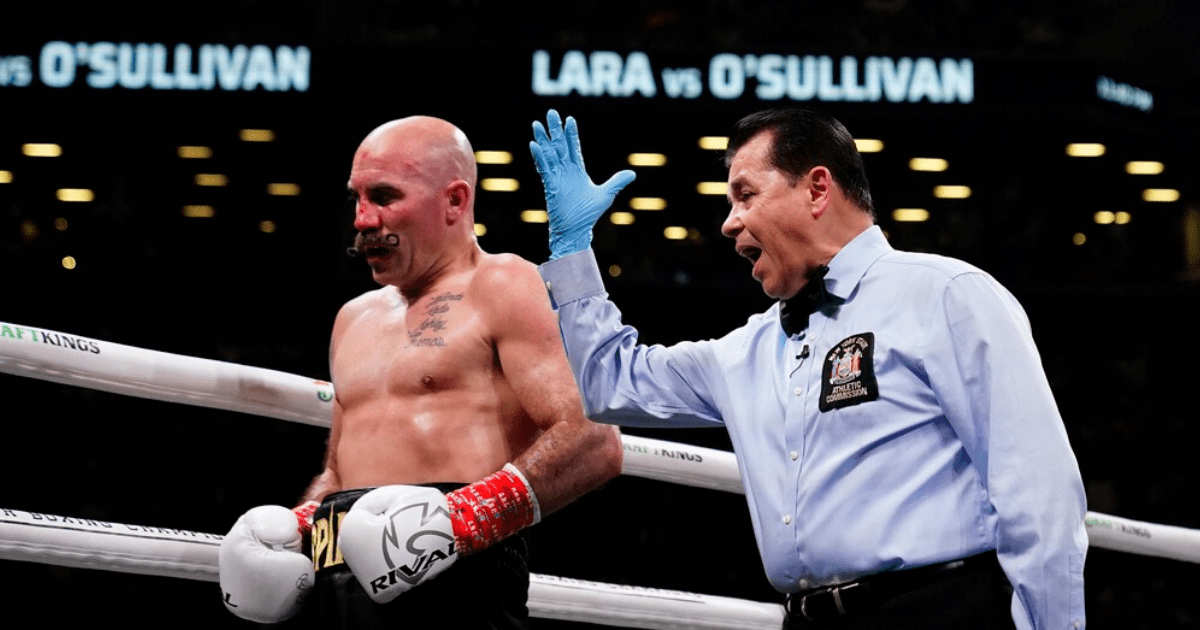BOXING referees are often spotted wearing gloves when in the ring.
The rubber gloves are different to those players wear, so why do do the referees wear them?
Referees are often spotted wearing gloves during fights.
Why do referees wear gloves in Boxing?
Referees wear gloves to prevent the transmission of contagious diseases. The rule was brought in during 1987, eight years after the discovery of AIDS.
The disease can be caught from blood and other bodily fluids, which referees can be covered in after brutal fights.
Referees are often spotted wearing rubber gloves during fights.
However, the referees faces are often seen covered in blood, so the gloves don’t go far in protecting them.
Has a referee ever been hurt in the ring?
A boxing referee has previously been KO’d with a punch to the chest by a fighter.
Mexican Jesus Granados was hurt after fighter Irvin Turrubiartes missed his opponent and landed a right hook on the referee’s solar plexus.
 Ref Jesus Granados took a punch to the chest from fighter Irvin Turrubiartes.
Ref Jesus Granados took a punch to the chest from fighter Irvin Turrubiartes.
Granados initially stayed on his feet but had to be stretchered out after doctors took a look at him.
What is the risk of a referee contracting a disease in the ring?
The risk of a ref catching a disease from a fighter today is almost impossible. Athletes must pass several medical tests to be able to fight, including HIV, Hepatitis A, B and C and Fungus tests.
These make it incredibly hard for a referee or opponent to catch a disease from the fight.
Frequently Asked Questions
Can you train yourself to box?
Yes, you can train yourself to box. Find a local boxing gym and sign up for a class. Most gyms offer free classes, but if you don’t see one nearby, you can always look up local boxing clubs on Google.
Also, you will need equipment such as gloves, mouthpiece, headgear, sparring partners, and headgear. Once you have this equipment, it’s time to start practicing your kicks.
How long does it take for you to learn boxing
Learning boxing takes around 3 months. This includes learning the basics like footwork, balance, and stance. Remember that boxing is more than just throwing punches. It’s important to be able to block and dodge punches.
How to defend yourself:
You must protect your head whenever you are attacked. It is your goal to not get punched. You must know how to stop an incoming punch. Here’s how to do it:
- Stand tall and square yourshoulders.
- Keep your elbows close together.
- Your forearm can block the punch coming from your opponent.
- Counterattack immediately.
- Continue blocking the attacker until he runs away.
- Never give up on your defense.
What is the best way to practice boxing punches in your home?
A punching bag can be used to practice boxing punches. You punch the bag until you feel like you’ve mastered the technique. Next, you’ll move on to the next part of your body. Once you feel confident with the area, move on to next.
Statistics
- This article received 39 testimonials and 89% of readers who voted found it helpful, earning it our reader-approved status. (wikihow.com)
- It is just like normal sparring with a partner, but you want to throw punches at 75% of your normal speed. (wikihow.com)
External Links
en.wikipedia.org
expertboxing.com
How To
How to learn to box for exercise
How to Learn to Box For Exercise
Learning boxing will help you improve your self-confidence and physical fitness. Boxing is one the most loved sports in the world. It requires speed, agility and strength.
Boxing can be a great exercise and a way to improve your self-esteem. You’ll enjoy it so much, you’ll want more.
There are many boxing training options. Some take place at gyms or health clubs while others require you to train at home. There are also online courses which allow you to study from anywhere in the world.
Make sure you choose a program that meets your needs and is compatible with your lifestyle. The best programs focus on exercises that increase muscle mass, flexibility and cardiovascular endurance. They also promote overall well being.
You should also consider whether you prefer a beginner’s course or a more advanced one. Beginner’s courses usually cover basic techniques such as shadowboxing or sparring, mittwork and punching combinations. Advanced programs usually cover more complicated movements and offer more options.
The beginner’s program usually lasts around 8 weeks and costs less than $100. These programs do not provide guidance about nutrition, weight, injury prevention or any other aspect of boxing training.
Advanced programs generally last around six months and cost approximately $300. These programs often include nutrition advice, stretching routines and warm-up exercises. They also provide instruction on proper technique. Some programs offer resistance training (such lifting weights) as well as aerobic conditioning (such running).

